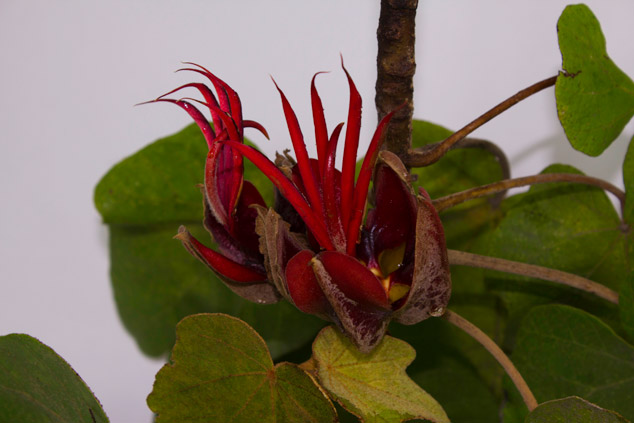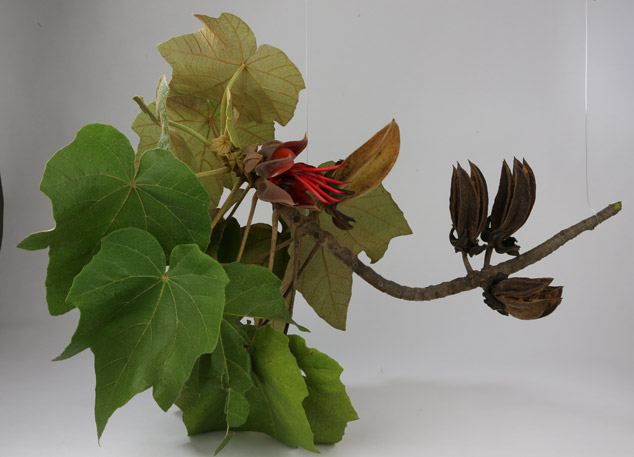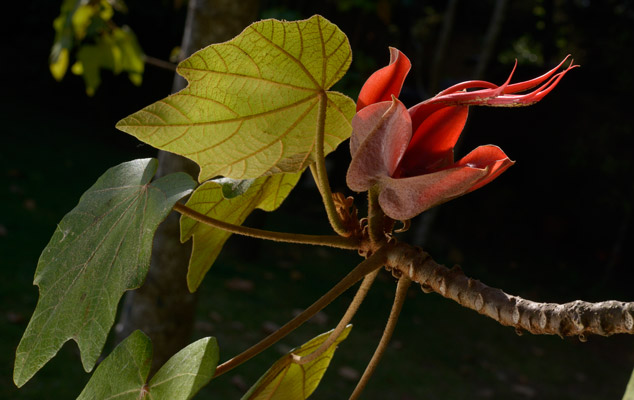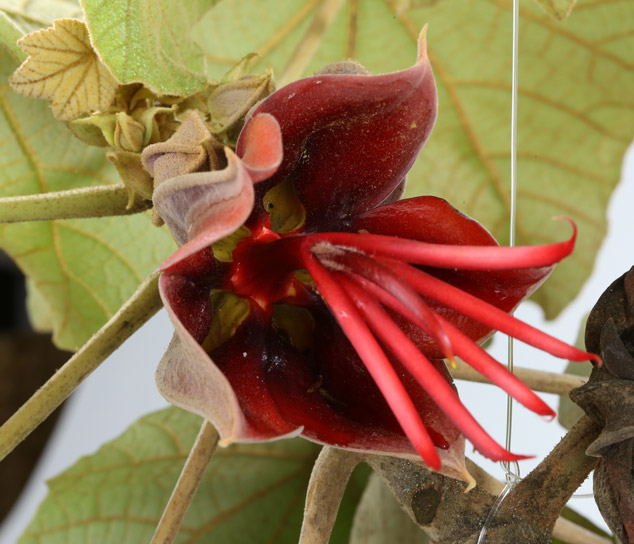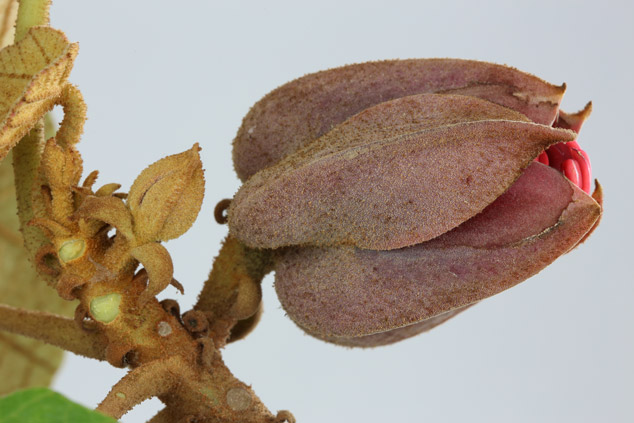Manitas, Canac, Chiranthodendron pentadactylon in Mesoamerica
My initial interest in Canac was because I noticed that the pod had the same kind of ridges as do the pods of cacao and pataxte. Subsequently I learned the similarity may result because they are in the same family Stercuiaceae.
Manitas tree; Mano de Mico; Canac Chiranthodendron pentadactylon; red flower.
Next I was attracted to the bizarre flower, probably one of the most unique and photogenic flowers in Guatemala.
Then, a year later, I noticed that these same flowers were a well known flavoring for cacao for the 16th century Aztec.
And then (December 2011), I noticed that the trunk has bumps on it, albeit not as perfectly conical as on a Ceiba pentandra. However a major issue with using photographs from the Internet is that many have an incorrect species attribution. The photo from a botanical web site showed a raised spot pattern on the trunk, but no individual protrubences. I will have to find the trees and inspect them in person.
Manitas tree; Canac; Chiranthodendron pentadactylon; red flower.
But once the tree was in front of me, the bizarre flowers so totally captivated my attention that I never even remembered to look at the trunk!
Almost every botanical web site and all the popular web sites either just show photos of the hand-shaped flowers or repeat what was said in earlier publications. I have not found a really helpful ethnobotanical study of this tree yet, but we have listed all the books which mention Chiranthodendron pentadactylon in Mexico and Guatemala.
Manitas tree; Canac; Chiranthodendron pentadactylon; red flower.
Since there are over 400 plants on our list of utilitarian plants of the Maya, I am constantly moving my interest from one plant to another. But several aspects of Chiranthodendron pentadactylon have caused me to focus on learning about this tree and its remarkable flowers.
- The flowers are used as flavoring for cacao
- The tree is distantly related to cacao and to another possible flavoring, Guazuma ulmifolia
- The leaves are edible
- The flowers are among the most photogenic in all Guatemala.
- The flowers are medicinal (in addition to being a flavoring for cacao)
Practical uses, other than symbolic
The leaves of this tree are used to wrap tamales, but seemingly more than just to wrap them; the leaves impart a flavor. Actually the leaves themselves can evidently be eaten.
Árbol de Manitas; Canac; Chiranthodendron pentadactylon; red flower.
In the market of Coban, Alta Verapaz, two of the largest vendors of medicinal plants had giant sacks of “manitas” flowers. This large quantity of these flowers suggests that they are readily available somewhere in the wild (I doubt they are cultivated).
I have seen large sacks of manitas flowers in the major markets in Guatemala City as well. The fact that each market has so many flowers suggests that these flowers are quite common.
The bark can be used to make rope (GlobalTrees.org).
List of species of Chiranthodendron pentadactylon in the Mesoamerican area
There is only one species in the genus Chiranthodendron. Parker places Chiranthodendron pentadactylon in the family of Sterculiaceae, which is the chocolate and cola family (Parker 2008:887). But others place it in the family: Malvaceae, subfamily: Bombacoideae (remember the bumps on the trunk).
Some synonyms include:
- Chiranthodendron platanoides
- Cheirostemon apetalum
- Cheirostemon platanoides http://davesgarden.com/guides/pf/go/66985/
Common names
The generic name - Chiranthodendron - is a combination of Greek words meaning "hand-flower-tree." Larreátegui notes that this was the name used by the Spanish botanists in Sessé's expedition, which studied the tree in 1787. The trivial name pentadactylon means "five-fingered." The tree flowers in winter, when the branches are otherwise bare. It was well-known long before the Spanish arrived in the 1500s; in the Aztec language Nahuatl it is called Macpalxochicuahuitl ("hand-flower-tree"). In Spanish it is called Árbol de las manitas ("tree of the little hands"), flor de manita ("flower of the little hand"), and manita or mano de león ("little hand, or hand, of a lion"); and in English, the hand-flower tree or Mexican hand plant (Hortus Third). (www.sil.si.edu/digitalcollections/nhrarebooks/larreategui/larreategui-introduction.html).
Manitas tree; Canac; Majagua (in Zacapa); Chiranthodendron pentadactylon; red flower.
We found that yes, the tree does flower in the cold months of winter, but the branches were not bare whatsoever. There were plenty of leaves on the trees.
Common Names: English: Devil's Hand Tree , Monkey´s Hand Tree, Hand Flower Tree. Spanish : árbol de la manita, árbol de las manitas, camxóchitl, canac, canaco, canague, huiahuonahua, lechillo, li-ma-ne-shmu, macpalxochicuáhuitl, macpalxóchitl, majagua, mano de dragón, mano de león, mano de mico, mapasúchil, mora, palo de mecate, palo liso, tayuyo, teyacua, teyeque. www.globaltrees.org/tp_devilshand.html
Habitat of Chiranthodendron pentadactylon in the Mesoamerican area
This tree seems to be more common in some areas of Highland Mexico and rather rare in Guatemala. In Guatemala it tends to occur in areas with pine such as near Sibinal, San Marcos. Indeed the name of the nearby volcano Tacana may be based on the name of the tree in Mam (Mayan language), though there are also two competing derivations
Luis Villar notes that it occurs in forests between 2000 and 3000 meters in the Guatemalan-Mexican border area (2005:72). The manitas trees that I was led to were at least 2000 meters, near Palestina area above Lake Atitlan.
Tecpan and San Pedro Sacatepequez, San Marcos are other places to look. Parker lists the Volcan de Agua (where it is called Tayuyo) and Volcan de Acatenango (2008:887).
Bibliography on Chiranthodendron pentadactylon
For a bibliography on Chiranthodendron pentadactylon we have a separate web page.
First posted March 11, 2013.


